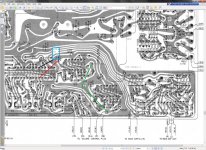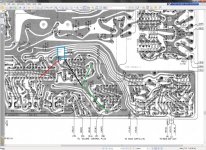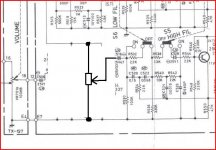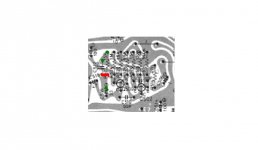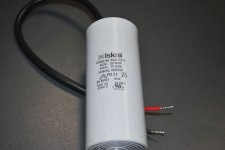It's no problem.
Lets analyse what you are saying for these DC faults...
C518 removed... yes and that is OK
C505 and C506 to ground... make sure it is the left hand ends of cap on circuit that go to ground. That is points 11 and 12 on the diagram.
" cap across R530 with minus leg also tied to the collector of Q503 "
I think you have an incorrect connection somewhere here. A cap across R530 will not alter the DC conditions.
"Minus leg tied to collector".... Not quite sure what you have done here. The collector is most positive point around where we are working. If you have connected Q503 collector to the minus leg on this cap then you have shorted out the transistor to ground. It won't damage anything though. That would explain the readings if that is what you have done.
Switch off and measure on ohms from Q503 collector to ground. Is it reading short circuit ?
Yes I connected Q503 collector to the minus leg on the cap, I will remove that connection tonight, see if my voltages come back and rerun test 1 and 2. Please look at the pictures and confirm if I got it right this time. Green lines depict how I shorted C505 and C506 to ground.
If both test give silence, can I continue to your assignment in post #198?
If so, to remove transistor is it enough to desolder just base, or emitter and collector should also be desoldered? I grew very fund of your trick to remove a cap it is enough to desolder only one leg
Attachments
That looks OK. The green lines are correct... we leave those as they are for now.
The cap is drawn OK and that is how I meant earlier And C518 removed.
And C518 removed.
The switch should be silent in both those conditions.
If all is good so far we then remove the 4.7uf cap you have drawn and refit C518
We want to bring it all back to having everything connected back up apart from C506/6 which we leave shorted to ground and also the volume control which we leave disconnected.
We test again and from previous results this was noisy again.
So then we do the test in post #198 of removing Q502 and then Q504 if needed.
To isolate the transistors you need to unsolder any two of the three leads... but make sure they are definitely isolated to ensure consistent results.
The cap is drawn OK and that is how I meant earlier
The switch should be silent in both those conditions.
If all is good so far we then remove the 4.7uf cap you have drawn and refit C518
We want to bring it all back to having everything connected back up apart from C506/6 which we leave shorted to ground and also the volume control which we leave disconnected.
We test again and from previous results this was noisy again.
So then we do the test in post #198 of removing Q502 and then Q504 if needed.
To isolate the transistors you need to unsolder any two of the three leads... but make sure they are definitely isolated to ensure consistent results.
That looks OK. The green lines are correct... we leave those as they are for now.
The cap is drawn OK and that is how I meant earlierAnd C518 removed.
The switch should be silent in both those conditions.
It is silent in both conditions.
If all is good so far we then remove the 4.7uf cap you have drawn and refit C518
We want to bring it all back to having everything connected back up apart from C506/6 which we leave shorted to ground and also the volume control which we leave disconnected.
We test again and from previous results this was noisy from right channel again.
C518 refited and it was noisy again.
So then we do the test in post #198 of removing Q502 and then Q504 if needed.
To isolate the transistors you need to unsolder any two of the three leads... but make sure they are definitely isolated to ensure consistent results.
Q502 removed, DC on Q504 collector went down to 5.09V but still noisy from right channel .
I removed Q504 and it was still noisy from right channel , but this time the popping was louder and sharper while operating switch then with Q504 in place, the difference between the two was not subtle
"Silent in both conditions". That's as it should be.
Everything else (and this is where it gets strange) points to some DC leakage through C518. That or a tiny change in the DC conditions that is coupling through C518 We swapped C518 way way back I'm sure.
Have you any other caps we can try for C518 ? Just to be sure beyond doubt that it's not that. Anything up to 10uF would be OK.
Having proved it is still noisy with another C518 fitted, keep the two transistors removed and now isolate C516.
Is it still noisy ?
If it is now continue by also isolating C510
Is it still noisy ?
Everything else (and this is where it gets strange) points to some DC leakage through C518. That or a tiny change in the DC conditions that is coupling through C518 We swapped C518 way way back I'm sure.
Have you any other caps we can try for C518 ? Just to be sure beyond doubt that it's not that. Anything up to 10uF would be OK.
Having proved it is still noisy with another C518 fitted, keep the two transistors removed and now isolate C516.
Is it still noisy ?
If it is now continue by also isolating C510
Is it still noisy ?
"Silent in both conditions". That's as it should be.
Everything else (and this is where it gets strange) points to some DC leakage through C518. That or a tiny change in the DC conditions that is coupling through C518 We swapped C518 way way back I'm sure.
Have you any other caps we can try for C518 ? Just to be sure beyond doubt that it's not that. Anything up to 10uF would be OK.
Having proved it is still noisy with another C518 fitted, keep the two transistors removed and now isolate C516.
Is it still noisy ?
If it is now continue by also isolating C510
Is it still noisy ?
You are right, we exchanged C518 already. Right now 4.7uF 50V FG Nichicon is there. I have a spare one, so I can exchange it again.
If I am getting a noise with C516 isolated and before I continue to isolate C510 should I refit C516 back?
Greetings
Marko
Lets swap C518 again just to be 100% sure  Watch the polarity. I'm tempted to say swap it with C517 (or use another totally different make of cap from another batch/manufacturer) which we know must be good as that channel is silent.
Watch the polarity. I'm tempted to say swap it with C517 (or use another totally different make of cap from another batch/manufacturer) which we know must be good as that channel is silent.
You can leave C516 isolated.
Now if all this still leads nowhere, this is what I think we should do.
You have your old volume control (or any pot or preset of 10K or more will do) ?
We connect across the supply to the preamp and connect the wiper to C518 and see if the noise varies with the applied voltage.
Really easy to do... two minutes of a job... I'll draw it.
But lets see where we get isolating these caps first ?
You can leave C516 isolated.
Now if all this still leads nowhere, this is what I think we should do.
You have your old volume control (or any pot or preset of 10K or more will do) ?
We connect across the supply to the preamp and connect the wiper to C518 and see if the noise varies with the applied voltage.
Really easy to do... two minutes of a job... I'll draw it.
But lets see where we get isolating these caps first ?
Like this. I have just blanked the circuit to draw the pot clearly. The pot goes across the supply and the wiper goes to C518 positive end (which must be isolated from Q504 etc.... just as drawn.
If you have 50v cap for C518 then there is no problem. If C518 is 25 volt then don't exceed that voltage as measured on the pot wiper as pot is turned.
If you have 50v cap for C518 then there is no problem. If C518 is 25 volt then don't exceed that voltage as measured on the pot wiper as pot is turned.
Attachments
Lets swap C518 again just to be 100% sureWatch the polarity. I'm tempted to say swap it with C517 (or use another totally different make of cap from another batch/manufacturer) which we know must be good as that channel is silent.
You can leave C516 isolated.
Now if all this still leads nowhere, this is what I think we should do.
You have your old volume control (or any pot or preset of 10K or more will do) ?
We connect across the supply to the preamp and connect the wiper to C518 and see if the noise varies with the applied voltage.
Really easy to do... two minutes of a job... I'll draw it.
But lets see where we get isolating these caps first ?
Will swap it then, I have some no name (KSC-KINGSUN ELECTRONIC) low-esr caps in 4.7uF value.
Or if I may suggest to perhaps bypass it with film or ceramic cap, that way we can be sure that no DC passes?
I did not stopped thinking as promised, I just can not
Attachments
Do you have a highish value plastic cap you can use instead of the electrolytic 4u7F?
Clean the PCB top and bottom around the cap pins. Old crud may be creating a high resistance circuit. Toothbrush and dishwashing liquid and warm water. Dry thoroughly before powering up.
Clean the PCB top and bottom around the cap pins. Old crud may be creating a high resistance circuit. Toothbrush and dishwashing liquid and warm water. Dry thoroughly before powering up.
Do you have a highish value plastic cap you can use instead of the electrolytic 4u7F?
Clean the PCB top and bottom around the cap pins. Old crud may be creating a high resistance circuit. Toothbrush and dishwashing liquid and warm water. Dry thoroughly before powering up.
Hi Andrew,
glad you are still following. Unfortunately I have nothing in so high value, 1uF tops.
Will check if there is any crud, but I highly doubt there is, poor C518 was removed and reinstalled so many times by now that I would have noticed something like that.
Do you have a highish value plastic cap you can use instead of the electrolytic 4u7F?
Clean the PCB top and bottom around the cap pins. Old crud may be creating a high resistance circuit. Toothbrush and dishwashing liquid and warm water. Dry thoroughly before powering up.
I correct myself, I just found this at work place
Attachments
Will swap it then, I have some no name (KSC-KINGSUN ELECTRONIC) low-esr caps in 4.7uF value.
They sound like "flying bomb" batteries
Or if I may suggest to perhaps bypass it with film or ceramic cap, that way we can be sure that no DC passes?
Don't bypass it, it won't achieve anything. If a cap is leaky it will still be leaky with another across it.
I did not stopped thinking as promised, I just can not, so I if you can look at the picture below, with green are marked the points I can normally touch with the red probe of DMM set to DC with ground probe to chassis, but if I touch the red point amp goes into the protection with a sound from the speaker very similar to what I experienced yesterday, while I repaired that soldering blob I completely unsoldered that side of R522 and checked on ohmmeter, it was good at 14.98K, that leaves C512 30pF ceramic cap. I know ceramic caps are very reliable, but what if this one has gone wrong, it is certainly in the right place as I see it?
I'll have to study what you mean with the picture
Ceramic caps in reality are very very unreliable (relatively speaking), particularly in older equipment. As a service tech many many faults were caused by the small "compressed disc" type ceramics.
That big cap looks like a "motor start" type, don't use that.
They sound like "flying bomb" batteries
Don't bypass it, it won't achieve anything. If a cap is leaky it will still be leaky with another across it.
I'll have to study what you mean with the pictureTouching any points in a high gain amp will cause all sorts of noises/oscillation etc so the protection relay clicking out is normal.
Ceramic caps in reality are very very unreliable (relatively speaking), particularly in older equipment. As a service tech many many faults were caused by the small "compressed disc" type ceramics.
That big cap looks like a "motor start" type, don't use that.
Hi Mooly,
you really do know everything, that is indeed a motor start cap. It was meant as a joke, after that "incident" with collector to the ground I am very careful with what I put where.
I will switch positions of C517 and C518, if the same channel stays noisy then we know it is not the cap causing it, if it moves to the other channel then we know the cap was leaky. Is that OK, good thinking?
If noise stays in the same channel I can put 1uF film cap in place of C518 for testing purposes, as AndrewT kindly suggested.
That point was the only point that ever made my amplifier go into protection while checking voltages, even its LEFT counterpart does not produce same behavior.
If you have a 1uf film handy then you can just fit that, otherwise swap the caps over.
It does sound a little strange that the amp goes unstable touching the point you show, and you say the other channel does not show this instability.
It's important that C516 is isolated after isolating the transistors following the order in post #204. C516 is part of the feedback network and it might object if the transistors were still in place.
It does sound a little strange that the amp goes unstable touching the point you show, and you say the other channel does not show this instability.
It's important that C516 is isolated after isolating the transistors following the order in post #204. C516 is part of the feedback network and it might object if the transistors were still in place.
If you have a 1uf film handy then you can just fit that, otherwise swap the caps over.
It does sound a little strange that the amp goes unstable touching the point you show, and you say the other channel does not show this instability.
It's important that C516 is isolated after isolating the transistors following the order in post #204. C516 is part of the feedback network and it might object if the transistors were still in place.
It turned out the highest value I have in film is 0.22uF, so I swapped the caps over. Unfortunately the noise remained in the same channel.
I left the transistors isolated when testing the day before so I removed C516, no change.
Then I removed C510, no change, right channel still noisy.
I just want to check something, in current setup, is it normal to measure 25V of DC across C518 (Q502- emitter and base desoldered, Q504-emitter and collector desoldered). And also the voltage on collector of Q503 risen to 14.6V.
I just want to check something, in current setup, is it normal to measure 25V of DC across C518 (Q502- emitter and base desoldered, Q504-emitter and collector desoldered). And also the voltage on collector of Q503 risen to 14.6V.
That sounds about right. The voltage across C518 (with transistors disconnected) should be the same as the supply to the preamp which is the voltage across C547.
So we still haven't cracked this. I'll have a think
That sounds about right. The voltage across C518 (with transistors disconnected) should be the same as the supply to the preamp which is the voltage across C547.
So we still haven't cracked this. I'll have a think
Can I ask you to think about this as well?
Sorry if my questions appear stupid, if I understand correctly increased noise in the current setup is in direct correlation with increased voltage across C518 as a result of removal of Q504 and Q502?
Can it be then that transistor change stopped popping in the right channel because new transistors are of lower gain and thus of lower voltage?
I have a feeling that if we replace C518 with 4.7uF film cap, or other non leaking type of cap that the popping would stop, but is that solving the root of the problem or just its side-effect? What is the negative side of keeping a cap across R530, which we proved is a method of bringing silence?
Thanks
Marko
Can I ask you to think about this as well?
Sorry if my questions appear stupid, if I understand correctly increased noise in the current setup is in direct correlation with increased voltage across C518 as a result of removal of Q504 and Q502?
Questions are no problem...
The increased voltage across C518 and increased noise appears to be the case and in a way doesn't make sense.
I'll try and explain it better a little later
Can it be then that transistor change stopped popping in the right channel because new transistors are of lower gain and thus of lower voltage?
The gain of the transistors shouldn't have any effect. That is because the DC conditions and the AC gain is set entirely by the passive components. And with the transistors isolated I would say it really should be silent... and that it isn't is a real puzzle. This is where rigging a pot up to bias C518 comes in. We have to do that to see just what the effect is.
I have a feeling that if we replace C518 with 4.7uF film cap, or other non leaking type of cap that the popping would stop, but is that solving the root of the problem or just its side-effect? What is the negative side of keeping a cap across R530, which we proved is a method of bringing silence?
The actual value of C518 isn't very critical. It does two things,
1. It prevents and DC from passing from Q504 to the next stage. The value of the cap has no effect on that property apart from how long it takes to initially charge. Big cap = long time
2. The value of the capacitor determines how well it passes low frequencies in the audio. If it's not big enough then the bass will be cut off.
If we just placed a cap across R530 then the amp would be very quiet... and all the time. It would just "short out" all the audio signal to ground.
- Status
- This old topic is closed. If you want to reopen this topic, contact a moderator using the "Report Post" button.
- Home
- Amplifiers
- Solid State
- Help with DC on volume pot
